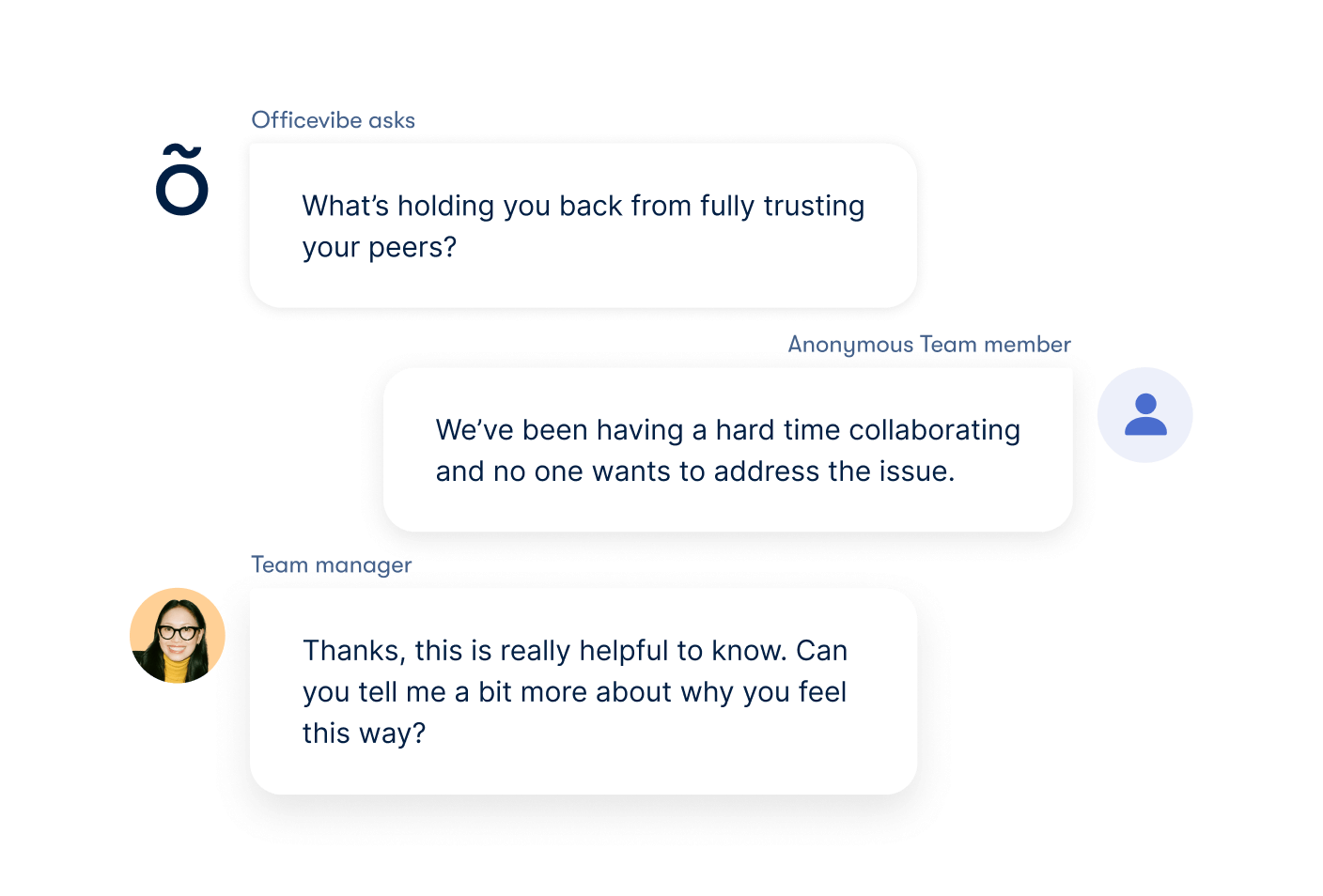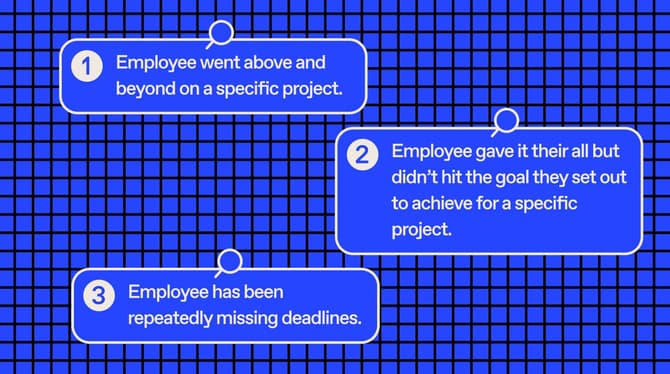Feedback is an essential tool to help employees understand their role and overall performance. Managers can use feedback to identify areas of improvement by using constructive employee feedback to correct mistakes or reward exceptional performance using positive feedback.
Both constructive and positive employee feedback are necessary for a healthy working environment.
Understanding how to provide positive feedback is the first step in empowering employees to put their best foot forward and feel accomplished every day.
Assess your organization’s employee experience in minutes

What's in this article
The benefits of positive employee feedback
Positive feedback helps reinforce behaviors and actions that have a beneficial impact on the employee, team, and organization. It's vital to building an encouraging, thoughtful work culture and a determinant of the overall level of happiness in the workplace.
Positive feedback helps motivate employees and shows them that they and that that do are valued. The list of benefits of positive employee feedback is ample, including improving productivity, upping employee engagement, and fortifying workplace relationships.
Promotes engagement
No matter how well-intentioned, negative feedback — or feedback perceived as negative — can sting. While it's a vital tool for correcting problematic behavior, it can also result in employees avoiding managers who appear too critical.
Positive reinforcement makes people feel good and can create a stronger connection between employees and management. And employees are looking to make that connection,
More than one quarter of employees don't feel like the feedback they receive is frequent enough to help them understand how to improve. And 22% are unsatisfied with the frequency of feedback coming from their direct manager.
Officevibe survey data
Employees who feel they can engage with management are often more likely to raise potential workplace concerns or problem areas within the business.
Supports a high standard of work
Having clear standards aligned with your organization's core values allows employees to engage with the type of behavior and work quality they expect from the company. Positive feedback lets employees know that they're on the right path and will encourage them to put in the extra effort to generate high-quality work.
Is cost-effective
A high turnover rate can be devastating for a business. It results in decreased productivity and reduced morale, but it also costs significantly more to hire a new employee than to retain an existing one.
Providing positive feedback improves employee performance, saving teams the additional cost of hiring new workers. It can help reduce costs and raise profits, and even a small change in employee engagement can lead to huge gains for the company.
Employees are 3.6 times more likely to strongly agree that they are motivated to do outstanding work when their manager provides daily (vs. annual) feedback.
Gallup, How Fast Feedback Fuels Performance
Reduces attrition
If a particular workplace gains a reputation as being a negative and highly critical place, it's less likely to attract the best talent or retain the talent it has. Positive feedback is important because it creates a trusting, open environment that is a pleasure to work in, making employee retention easier.
Encourages desired behaviors
Praise makes people feel good and want to repeat the behavior that prompted the praise. A combination of positive and negative feedback can effectively shape employee participation and promote specific behaviors. If you want to encourage your team to work harder, rewarding the extra efforts of a few team members can promote harder work in the entire team.
Positive feedback examples for employees
Giving feedback requires good communication skills to work. However, framing positive feedback as sincere, meaningful, and appreciative can pose a challenge, so planning ahead is vital. Having a few positive employee feedback examples on hand can ensure that managers deliver high-quality employee feedback that motivates employees and gives them the recognition they deserve.
Leadership
Some employees show strong leadership skills, rising to the occasion when their team needs them the most. Encouraging these skills can even prompt these individuals to consider a leadership role in the future.
Positive feedback examples for leadership include:
- I admire how you guided the team through this challenging project. It's reassuring to know that the team has someone like you who they can rely on that will encourage them to excel.
- We've seen notable improvements in employees' performance since you took over the team's leadership. Everyone seems to be more engaged and ready to work, and we look forward to seeing what you do in the future.
- Great job working as a leader in the team. Your proactive approach and strong leadership capabilities show you're set for more leadership roles in the future.
Performance
The secret of effective feedback is to reward employees whenever you see them doing a good job. It can be highly motivating to hear genuine admiration for their work without waiting for a performance review.
Here are some positive feedback examples when it comes to performance:
- I'm impressed with how quickly you completed all of your tasks. You did them quickly, and you also paid attention and avoided potential mistakes, showing that you're capable of excellent work on future projects.
- We appreciate your insight into this unexpected problem. Your ability to synthesize solutions and take risks helped us avoid a severe crisis, and we're very happy to have such a talented and intuitive person on the job.
- Thank you for your consistent hard work. It's reassuring to know that we have such a reliable member that gives all of their tasks the attention and care they need while still prioritizing the essentials.
Teamwork
Focusing on an employee's good qualities in teamwork will produce more consistent results and improved productivity.
Here are some examples to show these individuals that you notice their skills:
- Thank you for keeping your team in the loop during the last project. It allowed everyone to make informed decisions and ensured that we met all our deadlines and targets. We can't imagine the team without such a strong team player.
- Your handling of the conflict between your team members was admirable. You kept your cool and helped mediate the situation without it escalating any further. You're a vital member of this team, and we appreciate your team spirit.
- We've noticed that you've really stepped up as the contact point for the team. You keep everyone on the same page regarding targets and help struggling team members accomplish their tasks. Your helpfulness and organizational skills have helped this team thrive.
Noticeable effort
It's easy to coast along and meet expectations. Some employees are willing to go the extra mile, and encouraging this behavior with positive feedback shows others that you notice and reward hard work.
Here are some ways to provide feedback that recognizes strong efforts:
- You put so much effort into this project, and your determination inspires the rest of us as well. You're an asset to the team, and your focus helped us go beyond our original goals.
- Thank you for your passion and commitment during this project. While it didn't work out the way we expected, your hard work allowed us to learn valuable lessons that we can apply in future projects.
- We noticed that you put in a lot of extra work during the past couple of weeks, and it's yielding impressive results. Your dedication is an inspiration to the rest of the team, and we look forward to seeing what you can do in the future.
Communication
Good communication can bring teams together and help them exceed expectations.
Foster an attitude of camaraderie and open communication with positive employee feedback examples:
- I noticed that you went above and beyond in keeping everyone informed of the situation this week. Your check-ins ensured that everyone knew their role and responsibilities, allowing us to overcome these challenges.
- Thank you for always providing reports and regular check-ins in a timely manner. They help me coordinate with other teams and stay on track during the project.
- Your strong communication ability and positive attitude helped the team come together this week. It would have been easy for some details to slip through the cracks, but your efforts helped us catch and handle potential mistakes before they became problems.
Taking the initiative
Taking the initiative is a positive behavior that can be tricky to encourage. Most employees are reluctant to take risks due to potential negative consequences, and regular feedback can help strengthen employees' confidence.
Some feedback examples of how to inspire your employees to take more initiatives are:
- You demonstrated an admirable amount of initiative by taking proactive action on this project. Thanks to your problem-solving skills, we could avoid potentially costly mistakes.
- Good work on taking on the additional responsibilities last week. It helped us kickstart this project, and we're set to finish it in record time. Thank you for your efforts.
- Thank you for bringing the team together on such short notice to handle the problem today. I wouldn't have been able to call a meeting myself, and it's reassuring to know I have a potential leader I can rely on to take the reins when necessary.
Managing conflict
Conflict can be a driver of change and growth if managed correctly. Employees that can mediate and resolve conflicts effectively are invaluable in improving team productivity and promoting change in the organization.
Here are some examples of how to manage change and conflict with grace:
- I appreciate you stepping in to solve the conflict between the team today. Your ability to compromise helped us move past the issue and allowed us to meet our deadline.
- Thank you for cooling down the argument between your team members. By getting everyone on the same page, we were able to identify a new solution to the problem and exceeded our original goals.
- You're doing an amazing job relating to your former peers after your last promotion. It can be tough keeping lines of communication open, but you've navigated your new responsibilities like an expert.
Customer support
The core goal of most businesses is to acquire and retain customers. Having employees that are customer favorites can be a bonus.
It's good to have some positive feedback examples to keep them motivated:
- We received great feedback from your last client, who said that your expert advice was exactly what they needed to make a smooth transition to our product.
- Thank you for putting in the extra effort with the last client. They can be tricky to manage, but your patience and willingness to compromise ensure that they'll be loyal customers for years to come.
- You've received the top customer satisfaction rating for several months in a row. Your empathetic approach clearly works wonders, and we'd love you to share your strategy with the team.
Personal development
Most employees want to develop and grow as part of their careers. It's important to note these development milestones by giving feedback and encouraging employees to continue by providing support with positive feedback and constructive criticism.
Here are some examples of how you can acknowledge professional development and expertise:
- I'm amazed that you could master that skill in such a short time. Your ability to receive feedback definitely played a role, as did your determination to succeed.
- I noticed that you put in extra work to get up to speed with the new system. It's always good to see employees show initiative and study independently, but we're also happy to provide any additional training you may need.
- Your transition from shy intern to confident leader is inspiring and a huge motivation to the rest of the team. We look forward to seeing how you'll continue to hone your skills in the future!
New employee
New hires tend to feel overwhelmed or insecure during their first couple of weeks in a new office. By giving new employees positive feedback, you help foster a company culture of supportiveness that can help new workers relax and boost their confidence, leading to positive outcomes in the future.
Support new team members with feedback examples like:
- I know that you're still settling in, but the team has already noted your willingness to help and eagerness to learn. You're well on your way to becoming a critical team member.
- Thank you for sharing your insights into our onboarding process. We always appreciate employee input, and your advice helped us combat some flaws in the system.
- Good job speaking up in the team meeting this morning. It can be intimidating for a new member to provide feedback, but your confidence and positive energy mean that you'll fit in with the rest of the team in no time.
Best practices for giving positive feedback to employees
Giving employee feedback can be a challenge, but following a few simple principles can ensure that you give effective employee feedback during your feedback conversations.
Be specific
You want to reinforce good habits, so be sure to identify what the person did well. Vague feedback can feel insincere and make the employee feel unnoticed.
Give real-time feedback
Don't wait until the next meeting; identify and reward good work with positive feedback as soon as you see it happen.
Provide actionable feedback
If you're providing corrective feedback, guide the employee with usable ideas. It's easy to say you don't like how they do a task, but saying how you want a task done is significantly more effective.
Be genuine
Employees can tell if you're giving positive feedback simply to improve morale. While our employee feedback examples are a great baseline, you should still do your best to tailor your feedback example to the situation and person involved.
Stay compassionate
Some people view constructive feedback as negative, so it's vital to stay kind during the session and consider the employee's situation and feelings.
Let others know (if appropriate)
If you believe that an employee did something truly amazing, it may be worthwhile to acknowledge their contribution publicly. However, ensure that the employee is comfortable with the recognition before proceeding, as unwanted positive feedback may lead to potential conflicts.

Positive vs. constructive feedback
The main difference between positive and constructive feedback is that positive feedback acts as a motivational tool to enhance employee engagement with praise. Constructive feedback is a tool to address negative behaviors by providing actionable insights into how to address these issues.
Using negative feedback appropriately
Just like there's a time and place for positive feedback, there is that for negative. However, since negative feedback doesn't always land as comfortably as the latter, it is even more important to understand this type of feedback and how to deliver it appropriately.
What is negative feedback?
Negative or corrective feedback refers to identifying and correcting mistakes or wrong behaviors. Employees regularly make mistakes, but it can be tough to change their behavior until they know they're doing something wrong.
Using criticism effectively
Effective employee feedback may often require some form of negative commentary. If the employee fails to meet the company's organizational values, they need to receive negative criticism and actionable methods to correct their mistakes.
Many constructive employee feedback examples contain the "feedback sandwich," where you provide feedback after noting a positive aspect of the employee's work. This helps the employee take the feedback without getting defensive or affecting their job satisfaction.
The positive feedback loop
A positive employee feedback loop is when a company uses its employee feedback channel to improve its internal structure and workplace satisfaction. It leads to better business outcomes as employee engagement and productivity increase. Obtaining and taking note of employee feedback is often invaluable and should be a core value of any business. Most workers will provide informative feedback when related to their work.

A modern employee feedback software like Officevibe can help you activate a feedback loop like a pro. Use it to automate and organize how you collect anonymous feedback from your employees, no matter your team's size or location.
Quantifiable results and reporting take the guesswork out of identifying your team's pain points. When you can clearly see the areas where your employees are disengaged, you can address them before they choose to work elsewhere!
Equip HR and managers with tools to engage, recognize, and drive performance.




